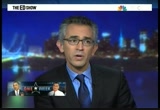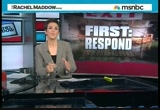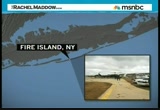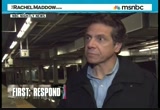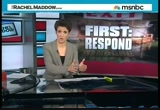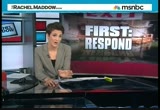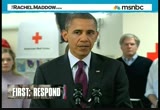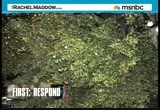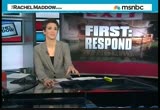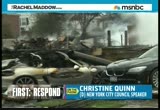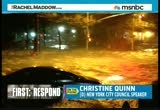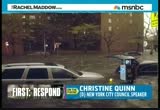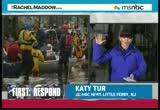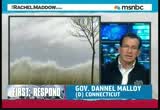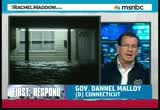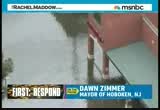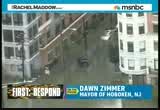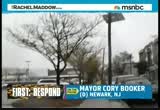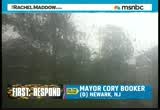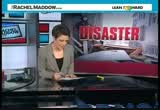tv The Rachel Maddow Show MSNBC October 31, 2012 4:00am-5:00am EDT
4:00 am
cross? i mean he just had a chance to be in a position of leadership and couldn't do it. >> go help, stop talking, take some action. >> richard wolffe, thanks for joining out. "the ed show." "the rachel maddow show" starts right now. >> good evening and thank you, my friend. thanks to you at home for staying with us. take a look at this map. this is a time lapsed map put together by "the new york times" starts at 4:00 a.m. yesterday morning. so 4:00 a.m. monday. it's more than half the entire east coast of the u.s. from virginia all the way up to maine and the yellow dots on this map represent people without power. so you see a little yellow dot here and there. this is how it looked at 4:00 a.m. yesterday morning. this is what happened next. this is at happened next. over the course of 24 hours, look at that. as sandy battered the eastern sea board 6 million customers were left in pitch black.
4:01 am
that swath of the eastern united states essentially totally blacked out over the course of one day. and at this hour, more than 6 million electricity customers remain without power in the east. when they say this is the largest storm to have ever hit the east coast of the united states, the word largest in that phrase actually just means the physical area that is covered by this storm, which you can see in the fact that we had outages from virginia to maine. but in terms of the direct hit of this storm, part of what makes this a storm of national significance is that when it came ashore, it hit the most populated place in our country. it's not just new york media dysmorphia. this is the most densely populated region of the country. new jersey's population is the most densely in the area. it is greater than the population of maine, new hampshire, montana, nebraska, north dakota, south dakota, and wyoming combined. all in a state that's significantly smaller than even
4:02 am
just new hampshire alone. the new york metropolitan area has a population of over 22 million people. when new york city evacuated just these areas in the five burrows for this storm, the people who were subject to just that order, just the people who live in the red area as marked on this map, just those people and just that population was larger than half the population of more than a handful of u.s. states. just the population in that evacuation area is the population of the whole city of new orleans and as you can see, this is just a fraction of that densely populated area. and a lot remain living under circumstances they have never lived in before. tonight rescue efforts here are ongoing in northern new jersey. several towns along the hackensack river were inundated with water when a tidal surge from the river overflowed its banks. normally the water rises up through the ground, but this time they said it came down the
4:03 am
streets and started pouring into their basements first like a trickle and then as one little boy will describe like a waterfall. they said there was no place to run, no place to hide. they literally had 15 to 45 minutes depending where you live in this 1.7-square mile town and most could not. >> we'll get a live report from that area in just a couple minutes. just off the southern shore of long island on the narrow barrier island that's called fire island, more than 120 people are reportedly stranded tonight after refusing initial orders to evacuate. people who tried to ride out the storm in their homes and are now trapped. first responders flew helicopters today over the island to find the best way to get people off of fire island but tonight there are still people reportedly trapped there. so the rescues are still ongoing at this hour. just a short time ago the governor of new york, andrew cuomo spoke with brian williams about the scale of the disaster that the city and state are now facing.
4:04 am
>> last night i'll tell you the truth, it was frightening. downtown manhattan, we had the hudson river came over the banks and was pouring into the ground zero site. at such a volume that it was really frightening and this was all filled with water. what we're looking at now, this goes back about five miles to the other end of the train track which is in new jersey. and we have to figure out how to pump out this water. >> think of the three governors, malloy, christie, cuomo rebuilding coastlines or at least talking about plans today are we the new amsterdam? >> well, you know, i said kiddingly the other day we have a 100-year flood every two years now. there is a frequency to this and this is really a new problem for new york state. we have not seen a flood like this, damage like this in our
4:05 am
generation, period. people who worked in the subway system, the construction industry in this state have said they've never seen damage like this, period. so it's a new reality for us and i think it's one that we're going to have to deal with. we're not going to give up. we're going to come back and we will and this city will rebuild and the state will rebuild and i believe we will be the better for it. >> you can hear in that discussion that there are really three different time frames here, right, there's the storm hitting, which is now done on the coast at least which created an immediate crisis, the drama of which really cannot be overstated, created heroic and hair-raising images like these ones of critical care patients being evacuated out of one of new york's major hospitals. here was the scene at another hospital. a human chain passing containers of fuel up 13 flights of stairs to keep the generator going.
4:06 am
this is in queens, flames as high as the eye can see absolutely engulfing blocks and blocks worth of homes. so that's one time frame, right? the storm and its immediate impact. then there is the third time frame, the long-term time frame which new york governor andrew cuomo is talking about in a way most others have been unwilling to which says in the long run there is a different future for a lot of america because of severe weather caused by climate change, severe weather that cities have never had to deal with before or who only had to deal with it only infrequently and who may now have to deal wit much more regularly. that's the final time frame, the immediate storm hitting and the long-term framework. but there's something in between, the second time frame. we are now in the time in between those two thing, after the immediate impact of the storm, there are some search and rescue efforts still ongoing, but what we are in right now
4:07 am
between that disaster and the long-term planning for how to deal with the new reality of a climate changed world, what we're in right now is essentially whole second disaster after the storm, not about the experience right now of wind and rain, but is the experience of a lot of people living in a metropolis of 8 million where hundreds of thousands of people have no power, many of them have no water, and nobody has any idea when it's coming back on board. yesterday it was the storm and last night was the storm and today is the start of a new disaster. it's about this many americans living in extreme conditions for a really indefinite period of time. during a stop at the red cross today in washington, president obama front page, this new challenge. >> obviously we're now moving into the recovery phase in a lot of the most severely affected areas, new jersey, new york, in particular, have been pounded by this storm. this is mostly a local responsibility and the private
4:08 am
utilities are going to have to lean forward but we are doing everything we can to provide them additional resources so that we can expedite getting power up and running in many of these communities. there are places like newark, new jersey, for example, where you have 80%, 90% of the people without power. we can't have a situation where that lasts for days on end. and so my instructions to the federal agency has been do not figure out why we can't do something. i want you to figure out how we do something. >> president there referencing 80% to 90% in newark, we cannot have a situation where that lasts for days on end much the president speaking about that this afternoon. we are getting new reports within the past hour that some the president's wish there may have come true. the mayor of newark, new jersey, is going to join us later on this hour on that subject. places like newark, new jersey age jersey city and hoboken and places entering into uncharted territory. i mean not just flooding, but
4:09 am
widespread if not complete power outages moving into their second day and going on for we do not know how long, whole coastal communities that have been inton dated and queens, new york, called breezy point that's been absolutely decimated by a massive fire, huge fire there last night that took more than 100 homes, there are places for which there is devastation, but there are also a lot of people who are in places in this most densely populated part of america, places that are standing but living in circumstances that would be challenging to anybody, something we have not done as a country for a very long time in a population center as big as this. the number of people without power in new york city alone is greater than the entire state population of vermont. i'm talking within the city limits. and those hundreds of thousands of people live very, very close to each other. this sort of city environment only allows people to live that close to one another because of the incredibly intensively used
4:10 am
infrastructure. it is infrastructure that allows this place to support this much life that allows us to cram this many humans into this small a space. and here's what some of that infrastructure looks like tonight. you're looking at -- what you're looking at here is a new york city subway station which now looks more like a dirty aquarium. new york city subway system is the veins underneath the city that provide life. they are the essential infrastructure that allows this city to operate. for the rich, the poor and the everybody in between. right now it is swamped. you can't even get down on to the platforms because water is everywhere. the u.s. army engineers have been called this to help drain the subways, a task that they've never had to do before. the manhattan borough president is calling this the biggest disaster in the 108-year history of the subway system. before this, the only place the army corps team had ever operated before was in new
4:11 am
orleans. but tonight they are on their way to new york city. this storm rolled through the most densely populated place in america last night. rescue efforts are still ongoing in this region today. in the long run the city is thinking about how it can adapt to survive more extreme weather and more frequent extreme weather if our new world is just going to keep being like this. but right now new york city has the unpress interdided challenge of getting three-quarters of a million americans without extended no water and no power and the aging infrastructure that makes this whole type of american life possible. joining us now is christine quinn, speaker quinn toured the storm and fire damage on the rockaway peninsula today. she joins us by phone. thank you for joining us. >> thank you. >> what's your assessment of the damage in the rockaways and the breezy point area today which you were able to see? >> well, the breezy point area, the fire is just devastating. the picture -- the images remind
4:12 am
you of the pictures you saw of world war ii, homes just burnt to the foundation, literally just a chimney standing in the midst of what had been over 110 homes. it was heartbreaking and as i was standing there senator schumer and i were there, people were coming to the area to check to see if their home had made it. they would walk from the evacuated area to breezy and see some with a degree of happiness and other people just with unbelievable sadness because they saw one that their home was one of the ones that had been burnt to the ground. but i have to tell you, rachel, as sad as it was and almost apocalyptic one of the first things somebody said to me, hey, quinn, make sure i get my building permits. so although this is tragic, there is no minimizing that there was a spirit there today that was truly a new york and
4:13 am
really a rockaway/breezy point spirit was they were going to get right back up on their feet and rebuild this community. >> christine, did you see any ongoing rescue efforts while you were still there today? are there any concerns there are still people trapped in their homes anywhere out in the rockaway peninsula or anywhere else in the five boroughs? >> in the breezy area we didn't see any ongoing rescue and amazingly no one was killed or seriously injured in that fire. earlier in the day, mayor bloomberg and senator schumer and i did a larger helicopter tour overbrooklyn and queens and staten aisle and see a helicopter rescue happening then, that was around 12:30 or 1:00. >> okay. in terms of lower manhattan right now, obviously you know the unprecedented nature of this large a power outage for this long a time. >> absolutely. >> and this densely populated an
4:14 am
area of america yet alone the city. tell us about your expectations when power might get back on and if it's going to be spotty or the whole island of manhattan coming back at once. >> just so folks understand it, basically manhattan south of 31st street is without power. some parts of manhattan were turned off in a preventive sense by con edison because they're fueled by steam. the fear was that there would be flooding when the cold water hits the hot steam, the machines would be basically ruined. so some of the systems we powered down. there was also a con ed facility on 14th street yesterday an off a that flooded from the east river. that created a small explosion. some power like the area i live in chelsea is out because of the explosion. what was powered down will come back more quickly, con ed is still assessing the damage at the trance former that will relate to other parts.
4:15 am
the third type of power outage is power that's out because of trees being down and having pulled down power lines. that's more in the boroughs outside of manhattan. as of the early this morning and around 9:00 we had 500,000 give or take buildings out without power. a customer in new york is a building so it's not necessarily the same as a person. 500,000. people have begun and buildings have begun to get power back. we could be at 400,000 now. i don't have an updated number. we will see rolling power come back on over the next few days, and con ed is working to get that done. it will not be, boom, everybody in all the boroughs back on. it will rock back on. >> how big a challenge in national terms do you think it's going to be for new york to repair the infrastructure damage that was done by this storm? i mean somebody watching the show is sitting there in wisconsin trying to get a handle on how big a national disaster
4:16 am
this is. when you look at the subway damage and power damage and other kinds of infrastructure damage how big a bill are we talking about here? >> well, it's hard to know how big a bill. i will say since we saw this storm coming and planned extensively, it's a lot less than it would have been. the decision to stop the subway from running gave us the ability to move all of the machinery out of the tunnel to higher ground. so the vast majority of the machinery was not damaged in the storm. that is an enormous, enormous difference. powering down the steam facilities will save the vast majority of that equipment. big difference than if we had just kept things running and had them get flooded. so that long-term thinking knowing that a bad storm was coming is going to save us not just money, but allow us to get back up and running much more quickly. >> new york city council speaker
4:17 am
christine quinn. thank you for calling in. i know you have a million things to do. thank you for being with us. hearing her talk about the importance of knowing it was coming and knowing that how big it was going to be and so, therefore, taking advantage of that advance warning to be able to power things down and that may be a multibillion dollar savings, not to mention the savings of lots of lives for new york city, want to know what that makes me happy about. that makes me happy about weather satellites and the national oceanic and atmospheric administration and the next time people say we should privatize that or weather satellites cost too much money and it's some sort of luxury, play this broad was for them. we'll be right back. doesn't hav. i'm done. [ female announcer ] unlike sprays and dust rags, swiffer 360 dusters extender can clean hard to reach places in less time. swiffer. great clean in less time. or your money back.
4:19 am
4:21 am
we just were given a look for the first time of the portions of the jersey shore by state police helicopter. houses are moved off their foundations. there are houses in the middle of route 35. a storm like sandy hits you expect to see damage along the coast as we have seen along the jersey shore but the new jersey towns of little ferry and moonachie and hackensack and south hackensack are several miles inland, but at around 10:00 last night the waters of the hackensack river just came pouring into those towns.
4:22 am
joining us from little ferry is katy tur. thank you for joining us. tell us what happened when the water came in there. i gather it was sudden and very scary. >> reporter: it came in within 15 minutes. it was all a sudden like it is now, probably less, there was no flooding and then six to ten feet high in most areas. at one point they were saying little ferry was 80% under water. we do have a little bit of good news to report for you, though, tonight, rachel. the power is back on in parts of this town which is a shocking thing for everybody to see here. the street lights are on. there are some houses that do have power. the majority, though, of this town is empty they've rescued 500 people from all these houses. they started at daybreak this morning. the levee broke around midnight but started at daybreak and so far have gotten 500 people out. we should show you the video. it's very dramatic. people leaving in rafts, canoes, boats, in military vehicles.
4:23 am
there are elderly people, there are children clinging to rescuers. cats and dogs, the water just didn't discriminate. they literally left in their pajamas in bare feet grabbing whatever they could and just getting out. that's how quickly the water came in and that's how dangerous it got. we're told what happened was that a levee for the hackensack river broke around midnight last night and that's when all this water rushed in. people around here are used to flooding. this is a part of new jersey that floods every year when there's rain and the water tables start to rise. they're used to it here and could not have expected this and were not told to evacuate or were in a flood-prone zone. not like the flooding they're used to. usually they see the water table rising a little bit. this just came in like a river all of a sudden on these streets. good news is though the federal government had search and rescue crews on the ready in this part of new jersey before the storm even hit so they were able to
4:24 am
get here relatively quick. the national guard was here. fema was here. they were all working with the local authorities and were able to do it pretty smoothly. they've stopped search and rescue efforts for tonight and say they've gotten all of the elderly and handicapped people out of the area. they will do it if there are emergency situations. they're not entirely sure how many are left in the houses. we did speak with some who said they were going to stay regardless, they didn't feel like it was much of a threat. the high tide, though comes in at midnight tonight and they are concerned about getting another four feet of water. right now it's receding a lot since we've been here for the past few hours the entire day mostly. we can show you what it looks like here and this is certainly what it looks like. you can hear the sounds of the activity here and the generators and sirens every once in a while but wove a hard time conveying is what it smells like. there's a lot of gasoline, a lot of sewage. you don't want to imagine, rachel. what's in all this water. >> and everybody needs to take
4:25 am
high tide seriously. one of the things leaders are telling us, to not think this is necessarily done. nbc news correspondent katy tur out in the middle of it. katy, hang in there, thanks. >> thanks for having me. much of the damage from sandy came from the water pushed on to land from the storm surge. the heavily populated region here, new york city is just the center of it. new jersey was hit by the storm surge. but on the other side to the east coast, sorry to the east along the long island sound, connecticut is dealing with storm surge and with widespread power outages. four were killed in the storm in the state of connecticut, 600,000 electricity customers there are doing without. homes were destroyed. the city of new haven just that one city is racing to clear 195 trees that fell on to city roadways in new haven. the governor of connecticut reassured the public that help is on the way that the job will get done. he has reassured his public that next week's big election will happen even if they have to count the ballots by hand. joining us is dan malloy.
4:26 am
governor malloy, we know you are busy. appreciate your time. >> a couple things i want to say. the magazine did a mav enough sent job. my fellow governors are doing a great job. my heart goes out to those folks. i used to be a prosecutor in new york. >> this is a tightly knit area because of the mutual commuting routes between states and because these are small states and tightly packed localities anyway. what i want to ask you between connecticut and new jersey and new york, all these municipal y municipalities how smoothly are things running in terms of coordination and whether you're getting what you need in connecticut. >> we've all been on the phone with the president a couple of times in the last few days. efforts are coming our way from all kinds much federal agencies, states are learning to work a little closer together. you know, the number one real line in america is actually
4:27 am
metro north through connecticut into new york city. we send a lot of people there. interestingly enough they send a lot of people out our way to work and we have to get that working and get people into grand central station and let them figure thought where to go from there. this is the third time my state in one year's period of time actually one year and six weeks, this is the third time that we've been through this. we got banged up very badly a year ago with irene much worse than other states. six weeks later we had a winter storm that wiped us out. we had 1.1 million people in our little -- our customers in our little state without power. tonight we have over 600,000 people without power. some of our towns were affected by all three of those events and some of those towns are 97% of people without power. we're getting used to it and becoming experts at it. >> in terms of the frequency of extreme we've seen governor
4:28 am
cuomo talking about it as planning on it to be the new normal. climate change is so politicized but if we are seeing frequent things of things that aren't supposed to happen what are you to do differently that you wouldn't have to do if you weren't facing these frequent and continuing events. >> i've been talking about climbed change since 1997. it's happened. it's alive and well in connecticut. number two, we have to raise a lot of infrastructure, that is literally lift it up off the ground and we have to think of our cities very differently than we thought about them in the past. you know, parking lots underneath -- you know, the first four, eight stories of buildings being parking lots may not be the prettiest thing to look at, but, but better you lose a parking lot than you lose a whole bunch of apartments or a whole bunch of business units. we're going to have to think about making our infrastructure
4:29 am
more protectable. i mean this thing in new york is absolutely the example. our problems with metro north are absolutely the example so we'll have to harden systems and have to spend money on hardening those systems, even while we're spending money to repair those systems. now, of course, there is a bigger question. in a country where people don't like to talk about infrastructure investment, at least half the people in the country don't like to talk about infrastructure investment, how are we going to get this thing done? we'll need leadership in the country that actually doesn't simply talk about europe or china's investment in awe and then not expect to repeat it here in the united states. we need to rebuild our infrastructure. we need to harden our infrastructure. we need to protect that infrastructure and we need to do that not for ourselves but for coming generations, not to make judgments about whether we're going to be able to compete with the rest of the world, it's whether our children or our grandchildren are going to be able to complete with the rest of the world. that was never a question for other american generations. but all of a sudden we are
4:30 am
questioning whether we should make those investments, at least some of us, i'm not. >> governor dan malloy, we know you're in the thick of it. thank you for your time tonight. we appreciate it. >> thank you. i have a modest proposal. how about this, so sometimes power goes out because of transformer explosions or because of innun san diegos of water. more frequently because a tree falls down on the power line. how about we do a big stimulus project for the country, infrastructure structure project wherein all of the places where the power went out because of hurricane sandy or something else in the past year, the trees are going to fall on the lines again, how about in all of those places we have a big nationally funded investment in infrastructure to bury the power lines. how about that? who would think that's a bad idea? just throwing it out there. we'll be right back.
4:34 am
if you want to understand the scale of devastation you might start in hoboken, new jersey. it's just across the hudden river from downtown manhattan, a short train ride away from manhattan. one of many places in new jersey where people live and commute to new york city or work right there in hoboken. the city has 50,000 people who live along a few dozen streets covering just about one squire mile. it is a lovely small town kind of place. and now much of it is under water. pushed by sandy, the hudson river flowed into hoboken's subway station and filled hoboken's streets. the city has banned driving and issued a curfew trying to keep people away from live power lines in the water. thousands are without power including city hall where hoboken officials are hunkered down with a generator answering questions from the stranded and from the weary and from people
4:35 am
who are wanting to volunteer to help. joining us now is dawn zimmer, the mayor of hoboken. mayor, thank you for making time for us. i appreciate it. >> thank you for having me on. >> can you tell us what is the state of things in hoboken, have you still got deep flooding, are you still doing rescues at this point? >> oh, yeah, we still have severe flooding in hoboken. probably half our city is flooded. we have 20,000 people that are still remain in their homes and, you know, we're trying to put together an evacuation plan, get the equipment here, trying to ask the national guard to help us and bring the equipment that we absolutely need. the payloaders aren't doing it. we can't get down so many city streets and concerned about the residents who are stranded in their homes right now and, you know, we've had like emergency situations and, you know, we just can't reach people. peeve p.a. systems but chargers and phones have run out so
4:36 am
concerned. >> is it a matter of typing people who are stranded or a matter of the fact that you know where people are but you physically can't get to them because the equipment either doesn't exist or it hasn't gotten there yet. >> oh, i mean we know where they are. they're in their buildings and half of hoboken is literally flooded and underwater and so, yeah, we don't have -- we have two payloaders and going in when we get the calls and trying to go in, you know, where we can to help people but the payloader, we have small city streets and they can't fit down all of the city streets and that's the only vehicles that we have to get down the city streets so we're begging and pleading and trying to get the national guard to give us the equipment to be able to get in. those high-level vehicles deuce and a quarter they're called so we can get down and either deliver more food to people if they need it or evacuate them if they need to be evacuated. it'll be another couple days.
4:37 am
>> what response have you had from the national guard and have you been told to expect equipment to arrive. >> we're hearing that some equipment is coming. we just received word tonight, so extremely hopeful it comes tonight or, you know, first thing tomorrow morning so we can get moving with, you know, making sure that people are okay. extremely concerned about hoboken residents who are stranded this their buildings right now. we can't get to them. >> sorry. i didn't mean to interrupt. >> yeah, i'm just worried about we have live wires in the waters and the waters are completely contaminated and i'm getting more contaminated every minute really because the sewage was completely flooded out so it's rainwater mixed with sewage water and becoming more sewage water. >> just to be clear in terms of getting the word out nationally this is not a situation that is in the past where hoboken went through something bad and you're reflecting on it.
4:38 am
it's ongoing. just to be clear, mayor, how many people do you think are still stranded in hoboken? >> i'd say about 25,000, 20,000 to 25,000 are still stranded. >> thanks, mayor. we will do what we can to connect you to the resources you need. all right. i want to show you newark, new jersey. this was newark new jersey, a city of 270,000 people. never an easy place but this was nuke after sandy moved through. almost entirely without power. all those people in one densely populated city with no idea when elevators and traffic signals would work again. we do not what happens to newark if it stays unplugged for very long but there it was, new jersey's largest city in near total darkness. they got the lights going again in much of newark. not all of it but much of it. and this is just as of hours ago. hoboken is still in the thick of it but newark appears to have
4:39 am
made some progress. the head of the local electric company got a congratulatory call from president obama himself. the quote you need to know here is great work, ralph, the president said and great work, newark, new jersey in terms of making this much progress. cory booker joins us, the mayor of newark. is it true the lights are coming back on in your city. >> yeah, they are. we still have over 100,000 people without power but we're grateful that large sections are starting to come online. as you said it's very danger us to have senior citizens in need of medication and have devices that need electricity for their health, so we still have a lot of those situations, but, you know, understanding what's going on in all of new jersey, thele devastation in the southern parts of our state, the challenges with my colleagues like dawn, we feel very grateful we're slowly making progress here. >> as the very hands-on leader
4:40 am
of your city, cory, what is your chief worry for your city right now? obviously you have to get those 100,000 customers back online as the rest of the city starts to come back to get power back but what are your main -- how would you rank your priorities? >> that is the number one. we're literally triaging lack of powary and will be doing food deliveries to people with high-need situations. we'll still have many places out throughout the night and that will be our focus but there's a lot of dangers and dangers from those -- they're made by residents reacting to the situation whether people using their stoves or candles to try to heat their apartments, whether it's the newly energized wires that were dormant before and people sort of learned that they weren't dangerous now becoming dangerous activating pools of water so the hazards are still there and we literally are looking for the prudence of our population to understand that we are still in a state of
4:41 am
emergency and there are a lot of dangers and we don't -- we were asking people not to add to them if they need help, call the emergency line, if they need help that's not an emergency we have a very great people of stalwart people that are manning nonemergency holt lines. if you allow 973-733-4311 for nonemergency transportation and i'm doing my best at the mobile command to react as well to constituent concerns. >> newark mayor, cory booker. keep us apprised. it's still an ongoing disaster in your city. keep us apprised, man. good luck. >> thanks for your attention. >> absolutely. tomorrow president obama and governor chris christie of new jersey are expected to be in newark. obviously that report from the hoboken mayor, from dawn zimmer is very distressing, the idea there might be as many as 20,000 people in hoboken who haven't been rescued because they're
4:42 am
physically not accessible. that the vehicles have not made it to hoboken to get those people out of where they need to be gotten out of. that's very distressing news but top level leadership from the country going there at least for a photo-op, hopefully that results in faster action in the city of hoboken. all right. the storm which has made things so tough on so many in the east today has also provided a window into the leadership styles of the men competing to be president of the united states for the next four years. some news on that is coming up. [ thunder crashes ] [ female announcer ] some people like to pretend a flood could never happen to them. and that their homeowners insurance protects them. [ thunder crashes ] it doesn't. stop pretending.
4:47 am
. jonathan shate said disasters are inherently political because government is political. and preventing and responding to disasters is a primary role of the state. right. and while a lot of politics has suddenly become irrelevant in the context of this crisis it does seem important now there is stark contrast between the two presidential candidates in terms of how they think a government should respond to a disaster. we know what president obama's stance is because we have been watching him act on it right now in realtime in this crisis he
4:48 am
has faced as president. his opponent governor romney proposed a very different way. he's argued that he essentially doesn't want a federal government role in disaster response. he made these remarks on the subject at a debate last year saying not only should we get rid of a federal disaster response, but maybe it should even just be taken over by private business. >> every time you have an occasion to take something from the federal government and send it back to the states, that's the right direction and if you can go even further and send it back to the private sector, that's even better. instead of thinking in the federal budget what we should cut, we should ask ourselves the opposite question, what should we keep? we should take all of what we're doing at the federal level and say what are the things we're doing that we don't have to do and those things we got to stop doing because we're borrowing $1.6 trillion more this year than we're taking in. we cannot -- we cannot afford to do those things without
4:49 am
jeopardizing the future for our kids. it is simply immoral in my view for us to continue to rack up larger and larger debts and pass them on to our kids knowing full well we'll all be dead and gone before it's paid off. makes no sense at all. >> that was how he responded to a question about fema. what he said about how he would respond to disasters if he were elected president and what the federal government's role should be. now that we are in the midst of a natural disaster that is ongoing in which there is a huge federal component to the response there is a pressing question to be asked, right? would a romney presidency not have the federal government involved in this response? would the romney presidency not have the federal government do what the federal government is doing right now in terms of response to sandy and get rid of fema. just let the states handle it, you take care of it on your own, there's no help for you? is that what he means? you'd give it to business even if you could. reporters who followed romney campaign tried to get the candidate to answer that question today.
4:50 am
many, many times. >> thanks for coming out this morning. >> governor, would you eliminate fema if you were president. >> good to see you. >> governor, what would you do with fema if you were president? >> thanks. >> governor, what should fema's role be? governor, would you eliminate fema if you were president? governor, what would you do with fema? >> governor, we've asked you what you would do. governor romney, would you eliminate fema. we've asked thaw question, sir. >> governor, are you going to eliminate fema? >> governor romney, do you still think that fema funding should be sent back to the states? >> governor romney, do you think that fema should be sent back to the states? hey, governor, do you think fema should be sent back to the states. >> governor, you've been asked 14 times what you would do with fema. why won't you answer? >> i said 14 times.
4:51 am
i don't know if it was 14. >> i don't know if it was 14. we counted up. it was 11 times at least in that one instance that mr. romney was asked. but here's another instance of it. how would getting rid of federal disaster response help this country in a situation like we're in right now? how seriously has mr. romney thought this through? did he mean that debate response? is that what we could expect from him as president and can we expect an answer before we are expected to vote? [ "everybody have fun tonight" plays ] really catching on! people can do it all! get a quote, buy and manage your policy! -[ music stops ] -it's great! well, what's with the... -[ music resumes ] -music? ♪ have fun tonight dude. getting a car insurance quote. i'll let it go to voicemail. [ clears throat ] ♪ everybody wang chung tonight ♪ putting it on vibrate. [ cell phone vibrates ] -[ loud vibrating ] -it'll pass. [ vibrating continues ] our giant store and your little phone. that's progressive mobile.
4:53 am
4:56 am
the reason we're here is because the red cross knows what it's doing when it comes to emergency response. and so for people all across country who have not been affected, now is the time to show the kind of generosity that, you know, makes america the greatest nation on earth and a good place to express that generosity is by contributing to the red cross. >> president obama today addressing the nation from red cross headquarters asking people to donate if they want to help with the response to hurricane sandy. the president canceled all campaign events today and tomorrow. his opponent, mitt romney, said he was canceling all campaign events. but this one did stay on the schedule.
4:57 am
romney/ryan victory rally, dayton, ohio, october 30th. it was tweeted out by reporter ari shapiro. it was previously planned as a campaign rally and kept it in the same place and same time and had mr. romney appear with the same celebrity endorsers scheduled for the rally then led the whole thing with the vote for mitt romney buy graphical video from the republican convention that they played to start all of their campaign rallies but because they wanted credit for canceling all their rallies out of sensitivity to the people suffering from this storm, they went ahead with this one mostly as planned but they said they did not want it to be described as a rally, instead they wanted people to call it a storm relief event. they did ask people attending the rally to bring canned goods as storm relief and mr. romney did a big ornate show of seeming to handle them which they said would be donated to the red cross so got the photo-op they
4:58 am
wanted but as a presidential candidate it models what mr. romney believes to be the appropriate way to help if you are concerned about this giant disaster and that's the problem. because however well mr. romney's piles of cans worked for him as a photo-op that isn't actually what the red cross wants or needs people to do to actually help. look at the red cross website. question, i would like to donate clothes cars or other items to charity, does the red cross accept them? >> rough, due to constraints the red cross does not accept or solicit donations of or collections of items such as collected food, shoes must be cleaned and repackaged which impedes moneying time and personnel. financial contributions allow them to purchase exactly what needed for a disaster relief operation. people have an inassistant to gather up blankets and canned goods and warm clothes and things they think are of direct help. a laudable instinct. every once in a while there is a
4:59 am
direct need for a specific physical thing to be donated in which case relief organizations ask for that but otherwise canned goods and other random supplies mostly just give these organizations a whole new extra job they don't want to be doing right now sorting through and storing random stuff they didn't ask for. it's a positive instinct that makes us want to give stuff like canned food and groceries and also true that those kind of donations are generally not much of a help and one of the things we need public leadership for is bridge the gap of what feels like helping and what actually does help. this is one of those things you need visible competent calm public leadership for to say actually it's coming from the right place but what the red cross needs from you is not canned goods, it's money and here's why. this is not a hypothetical thing. this is one of the things you're supposed to do as a leader at a time of crisis. if you do want to help send upon to the american red cross. call 1-800-red cross or go t
122 Views
IN COLLECTIONS
MSNBC Television Archive
Television Archive  Television Archive News Search Service
Television Archive News Search Service  The Chin Grimes TV News Archive
The Chin Grimes TV News Archive 
Uploaded by TV Archive on

 Live Music Archive
Live Music Archive Librivox Free Audio
Librivox Free Audio Metropolitan Museum
Metropolitan Museum Cleveland Museum of Art
Cleveland Museum of Art Internet Arcade
Internet Arcade Console Living Room
Console Living Room Books to Borrow
Books to Borrow Open Library
Open Library TV News
TV News Understanding 9/11
Understanding 9/11